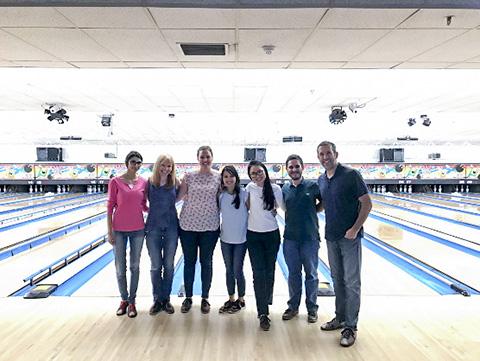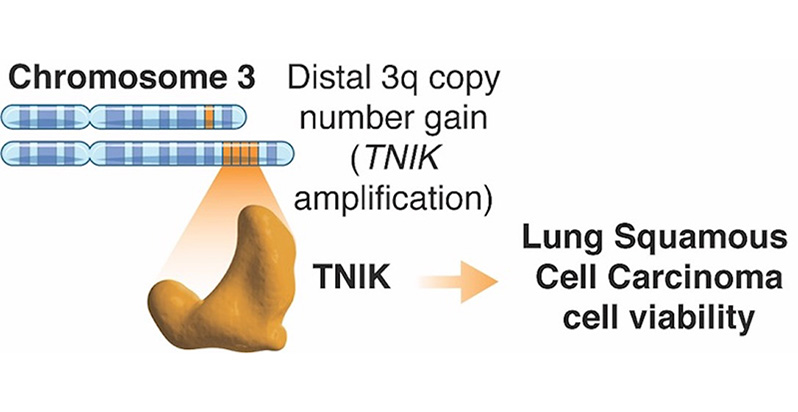Researchers have found a potential therapeutic target for lung squamous cell carcinoma (LSCC), the second most prevalent type of lung cancer. This may pave the way for a targeted therapy for LSCC, which currently has no approved targeted therapies.
The researchers discovered that TNIK, a type of molecule known as a protein kinase, exists in higher levels in approximately 50% of LSCC patients and that inhibiting TNIK reduced tumor activity in the laboratory and tumor growth in animal models of LSCC. They reported the findings in Cancer Discovery.
“In my lab, we want to tackle these cancers of unmet need [like LSCC],” said John Brognard, Ph.D., an investigator in the National Cancer Institute at Frederick’s Laboratory of Cell and Developmental Signaling and the senior author on the study. His lab studies how kinases promote tumorigenesis.
Finding a potential way to target LSCC is a major advance because LSCC treatment hasn’t changed much over the last three decades, unlike treatments for other cancers.
“Ideally, we would like to treat patients with targeted therapies, which go toward specific components in the tumor, with the idea that they are going to be more efficient in reducing tumor growth,” said Pedro Torres-Ayuso, Ph.D., a visiting postdoctoral fellow in Brognard’s laboratory and lead author on the paper.
“Because there is a low expression of TNIK in normal cells in the body, TNIK inhibitors should only affect cancer cells with high levels of TNIK expression that rely on TNIK for cell survival. Thus, they’d only target the tumor and not normal cells, so they should also be less toxic,” he added.
A Rigorous Process
The researchers already had reasons to believe TNIK would be a good target. They determined, through analysis of publicly available data from the Cancer Genome Atlas program, that there were extra copies of the TNIK gene, a marker of cancer, in up to 50% of LSCC patients. TNIK, a product of the gene, is also a known driver or target in colorectal cancer, so they thought they would be successful pursuing it.
To study TNIK’s effect on LSCC, they tested a TNIK inhibitor in cell lines derived from LSCC patients and in mouse models of human LSCC. The inhibitor reduced tumor cell viability in both models, and it dramatically slowed tumor growth in mice.
Thanks to meticulous study controls, their results were confirmed to be specific to TNIK inhibition, meaning that finding the right therapy to target TNIK will hopefully help many patients with LSCC someday.
The Key to How It Works
Finding a specific target wasn’t the stopping point. Torres-Ayuso wanted to understand the mechanisms behind how TNIK helps to keep LSCC cells alive.
“We are convinced that by knowing better how these tumors behave, we can find new treatments or better treatment options for patients suffering with these tumor types,” he said.
The key for TNIK is a protein called Merlin. TNIK promotes tumor growth by phosphorylating (a process that is necessary for transmitting many signals in a cell) Merlin, which is required for maintaining a molecular chain reaction that contributes to the cancer cells’ proliferation and survival.
“I’m happy our study is contributing to shed some light in how to better treat this tumor. Any single effort we can make is definitely worth it,” Torres-Ayuso said.
Only the Beginning
Despite their newfound knowledge, the researchers know there’s more work to do.
They want to address more questions about TNIK’s role in cancer biology, like if there are other tumors for which it can be a target and whether it works through any other mechanisms.
They also want to pursue additional ways to target TNIK. Though the inhibitor they used in the study worked well, it isn’t potent or safe enough to use on patients in the clinic, so something else needs to be found.
“Definitely this is not a finished job. I would say this is … the start, to open new doors. I am sure that there are still many discoveries with TNIK to be made,” said Torres-Ayuso.
Science Is Better as Teamwork
Some of this work will be continued in Brognard’s laboratory, and Brognard acknowledges that some of it may end up going with Torres-Ayuso when the trainee is one day able to start his own laboratory.
“That’s one of the things we’re encouraged to do at the NCI. We want to help the next generation of scientists be successful and take their research with them,” said Brognard, who himself once held an internship at NCI at Frederick.
Brognard said he encouraged Torres-Ayuso to “take the reins” on this study to help him develop as a scientist.
“I was supported—very supported, indeed—by my mentor, Dr. John Brognard,” Torres-Ayuso said. It’s the latest part of his mentorship under Brognard, which has included support and training that led to him claiming an award at the 2019 Spring Research Festival.
This camaraderie doesn’t end in Brognard’s laboratory. The study involved close collaboration with many people, including other groups at the Laboratory of Cell and Developmental Signaling, the Frederick National Laboratory for Cancer Research, and the Yale School of Medicine.
“The way science works now … we can no longer aim to do everything or get to know everything. This was actually a great opportunity to bring several experts together,” Torres-Ayuso said.
The researchers teamed up with their collaborators to rely on their technical expertise to accomplish various aspects of the study. For example, some of their collaborators assisted in identifying sites of phosphorylation through a technique called phosphopeptide mapping, performing the in vivo studies, and identifying Merlin as a potential mechanism.
“Science is better done as teamwork, in my opinion, and multiple heads coming together to come up with the best approaches and ideas,” Brognard said.
Karolina Wilk is a science communications and training specialist in Scientific Publications, Graphics & Media (SPGM), where she writes for NCI at Frederick and Frederick National Laboratory’s news outlets; manages the production of SPGM communications trainings; and edits scientific manuscripts, corporate documentation, and other writing. SPGM is the facilities’ creative services department and hub for editing, illustration, graphic design, formatting, and multimedia training and support.



